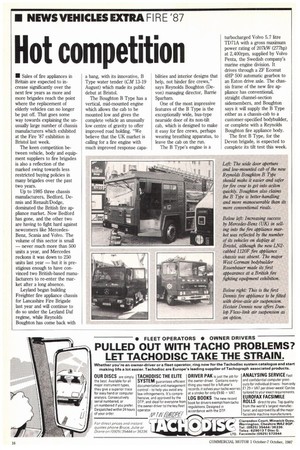ot competition
Page 18

If you've noticed an error in this article please click here to report it so we can fix it.
• Sales of fire appliances in Britain are expected to increase significantly over the next few years as more and more brigades reach the point where the replacement of elderly vehicles can no longer be put off. That goes some way towards explaining the unusually large number of chassis manufacturers which exhibited at the Fire '87 exhibition in Bristol last week.
The keen competition between vehicle, body and equipment suppliers to fire brigades is also a reflection of the marked swing towards less restricted buying policies in many brigades over the past two years.
Up to 1985 three chassis manufacturers, Bedford, Dennis and Renault/Dodge, dominated the British fire appliance market. Now Bedford has gone, and the other two are having to fight hard against newcomers like MercedesBenz, Scalia and Volvo. The volume of this sector is small — never much more than 500 units a year, and Mercedes reckons it was down to 250 units last year — but it is prestigious enough to have convinced two British-based manufacturers to re-enter the market after a long absence.
Leyland began building Freighter fire appliance chassis for Lancashire Fire Brigade last year and will continue to do so under the Leyland Daf regime, while Reynolds Boughton has come back with a bang, with its innovative, B Type water tender (CM 13-19 August) which made its public debut at Bristol.
The Boughton B Type has a vertical, mid-mounted engine which allows the cab to be mounted low and gives the complete vehicle an unusually low centre of gravity to offer improved road holding. We believe that the UK market is calling for a fire engine with much improved response capa bilities and interior designs that help, not hinder fire crews," says Reynolds Boughton (Devon) managing director, Barrie Sparham.
One of the most impressive features of the B Type is the exceptionally wide, bus-type nearside door of its non-tilt cab, which is designed to make it easy for fire crews, perhaps wearing breathing apparatus, to leave the cab on the run.
The B Type's engine is a turbocharged Volvo 5.7 litre TD71A with a gross maximum power rating of 207kW (277hp) at 2,400rpm, supplied by Volvo Penta, the Swedish company's marine engine division. It drives through a ZF Ecomat 4HP 500 automatic gearbox to an Eaton drive axle. The chassis frame of the new fire appliance has conventional, straight channel-section sidemembers, and Boughton says it will supply the B Type either as a chassis-cab to a customer-specified bodybuilder, or complete with a Reynolds Boughton fire appliance body.
The first B Type, for the Devon brigade, is expected to complete its tilt test this week.












































































































